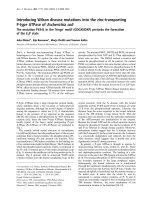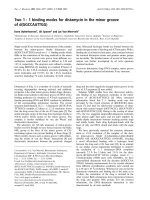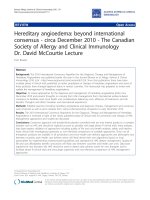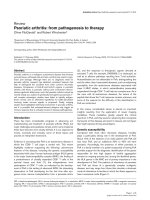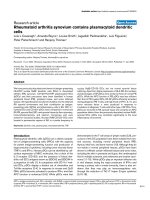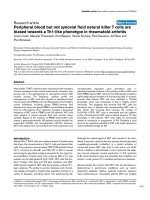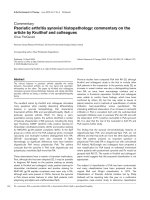Báo cáo y học: "Introducing Arthritis Research & Therapy’s 10th anniversary issue, ‘The Scientific Basis of Rheumatology: A Decade of Progress’" pdf
Bạn đang xem bản rút gọn của tài liệu. Xem và tải ngay bản đầy đủ của tài liệu tại đây (98.99 KB, 3 trang )
Page 1 of 3
(page number not for citation purposes)
Available online />Introduction
Arthritis Research & Therapy is publishing a comprehensive
collection of review articles, entitled ‘The Scientific Basis of
Rheumatology: A Decade of Progress’, to mark its 10th
anniversary. This special collection of reviews will provide an in-
depth overview of the current status of basic and clinical
research in rheumatology and will focus particularly on
developments in the past decade, during which there has been
an explosion of new information in this field. Half of the reviews
will focus on biologic processes underlying rheumatic diseases
and the other half will analyze clinical developments in specific
rheumatic diseases. This special edition includes 40 reviews by
internationally recognized experts and will provide both
researchers and clinicians with a comprehensive understanding
of the scientific basis of rheumatology. We believe that this
special issue will become an essential reference in the field.
The original goal of the journal, which was launched in 1999
as Arthritis Research, was to provide cutting edge original
reports of research as well as comprehensive reviews of all
research topics related to rheumatology. In 2003, the name
of the journal was changed to Arthritis Research & Therapy
to denote the journal’s aim of incorporating translational
aspects of rheumatology within its pages.
In the decade since the first biologic agents – infliximab and
etanercept – were introduced into rheumatology, the field has
changed dramatically, both clinically and as an investigative
discipline. The articles in the 10th anniversary special issue
reflect the tremendous growth in the scope of rheumatology
and the understanding of rheumatic diseases which has
occurred during this decade. ‘The Scientific Basis of
Rheumatology: A Decade of Progress’ is designed to provide
the reader with a comprehensive review of the many research
and translational aspects of rheumatology which serve to
make it a dynamic and rapidly evolving field.
The first part of the special issue will include 9 articles.
Subsequent parts will include the additional 31 articles that
will complete the special issue. These will be available online
immediately upon peer review and acceptance, and
subsequently in printed issues of Arthritis Research &
Therapy. Immediate online publication is consistent with the
commitment of Arthritis Research & Therapy to provide rapid
availability of important contributions to the field and also the
capacity to search for relevant references in an integrated
manner, whereas print publication gives the reader the
advantages of a traditional review text.
Overview of part one of The Scientific Basis
of Rheumatology: A Decade of Progress
Biology and methodology
The contribution of Foxwell and colleagues [1] focuses on the
role of signalling pathways in macrophages, the principal
innate immune effector cells of rheumatoid arthritis. Evidence
of the influence of innate immune cells in disease progression
is also reviewed.
Mesenchymal stem cells (MSCs), nonhematopoietic pro-
genitor cells found in various adult tissues, have the potential
to repair tissue damage caused by osteoarthritis and
rheumatoid arthritis. Chen and Tuan [2] discuss the potential
involvement of MSCs in the pathophysiology of degenerative
joint disease and explore the prospects of MSC-based
therapies for these common rheumatic conditions.
Evidence for the involvement of epigenetic factors in rheu-
matic diseases has accumulated over several decades.
However, in recent years, the effects of environmental
triggers that cause heritable genetic changes without altering
nucleotide sequence are becoming more widely elucidated,
especially in the pathogenesis of rheumatoid arthritis. Gay
and colleagues [3] explore the experimental evidence for the
Editorial
Introducing
Arthritis Research & Therapy
’s 10th anniversary
issue, ‘The Scientific Basis of Rheumatology: A Decade of
Progress’
Iain Hrynaszkiewicz
1
, Peter E Lipsky
2
and Ravinder N Maini
2
1
Managing Editor, Arthritis Research & Therapy, 34-42 Cleveland Street, London, W1T 4LB, UK
2
Editor-in-Chief, Arthritis Research & Therapy, 34-42 Cleveland Street, London, W1T 4LB, UK
Published: 10 October 2008 Arthritis Research & Therapy 2008, 10:119 (doi:10.1186/ar2522)
This article is online at />© 2008 BioMed Central Ltd
MSC = mesenchymal stem cell.
Page 2 of 3
(page number not for citation purposes)
Arthritis Research & Therapy Vol 10 No 5 Hrynaszkiewicz et al.
role of epigenetic risk factors, which may assist in the
development of novel molecular-based therapy.
Szekanecz and Koch [4] review the crucial involvement of the
vasculature in inflammatory rheumatic diseases, including the
role of the vasculature in atherosclerosis and increased
cardiovascular risk, leading to increased mortality. The cellular
mechanisms underlying these pathologic processes are
described, and the possibility of therapeutic vascular target-
ing summarized.
Immunoablative therapy and hematopoietic stem cell
transplantation in autoimmune diseases are the subjects of
the article by Hügle and van Laar [5]. They review the
available evidence of this intensive therapy – traditionally, a
salvage therapy for nonresponders to conventional treat-
ments – from retrospective cohort analyses, case series and
translational studies and look forward to the outcomes of
prospective randomized controlled clinical trials in systemic
sclerosis and systemic lupus erythematosus.
Our view of rheumatic diseases has also changed sub-
stantially with the development of imaging techniques, which
have improved our ability to observe the structure and
function and pathogenic mechanisms of rheumatic disease
more effectively. As discussed by McGonagle and Tan [6],
magnetic resonance imaging permits the in vivo imaging of
pathogeneic mechanisms in rheumatoid arthritis, with future
technology potentially being able to explore disease at the
cellular and molecular levels.
Specific rheumatic diseases
Developments in the scientific understanding of systemic
lupus erythematosus are the focus of the contribution of
Ardoin and Pisetsky [7], who review recent research into
immune abnormalities in the disease, the scientific basis of
which is leading to opportunities for developing more
targeted treatment and a ‘new era’ of clinical trials.
Gout, an increasingly common form of inflammatory arthritis
(especially in the elderly), initiated through the deposition of
Box 1. The growth of Arthritis Research & Therapy and open access publishing
All primary research articles have been freely available through the National Institutes of Health (NIH) repository of
biomedical research articles, PubMed Central, since its launch in 2000. Arthritis Research & Therapy transferred to
BioMed Central, the first open access publisher, the same year.
By being open access, all Arthritis Research & Therapy research articles are freely and universally accessible online,
making them much more visible compared with journals that publish all of their content behind subscription barriers. As of
this writing, more than 90,000 articles, on average, are downloaded per month from the journal website.
Many publishers now offer open access options, as recognition of the model has grown. Many funding agencies now
require deposition of accepted articles in a public repository such as PubMed Central. The Wellcome Trust and the
Arthritis Research Campaign have established such policies, and more recently the NIH Public Access Policy came into
effect in April 2008.
Arthritis Research & Therapy has now published over 700 original research articles and more than 200 reviews. The
journal received its first Impact Factor in 2003, placing it third in the field. Other measures of a journal’s success such as
the SCImago Journal Rank also rank the journal highly.
Box 2. Benefits of publishing with Arthritis Research & Therapy
Online functionality enables rapid peer review and publication. Authors can expect to receive a first decision on their
manuscript within six weeks of submission.
Research is published as a ‘provisional PDF’ immediately upon formal acceptance and is indexed in PubMed within
48 hours.
Authors can be published within as little as 2 to 3 months of initial submission.
Research articles have no length restrictions or limitations on the number of colour figures, tables, or supplementary
materials that can be included, enabling scientists to produce a true record of their work.
Page 3 of 3
(page number not for citation purposes)
monosodium urate crystals in the joint, is explored in the
article by So [8]. So reviews both recent scientific and clinical
experiments, which have provided new insights into uric acid
transport, the basis of inflammation in gout and novel
hyperuricemia-reducing drug trials.
The past decade has also seen scientific and clinical
developments within the idiopathic inflammatory myopathies,
diseases with not-yet-determined pathogeneses. Lundberg
and Grundtman [9] describe available evidence for the
immunological and nonimmunological basis of disease and
the implications for future treatment options.
The Scientific Basis of Rheumatology: A Decade of Progress
should provide the reader with an easily accessible,
comprehensive and user-friendly review of the remarkable
progress in rheumatology in the past decade. We hope it will
not only give the basic investigator a comprehensive overview
of the state of knowledge of rheumatology, but also provide
the clinician an opportunity to understand the remarkable
scientific developments in rheumatology which serve as the
basis for modern therapeutic programs.
References
1. Drexler SK, Kong PL, Wales J, Foxwell BM: Cell signalling in
macrophages, the principal innate immune effector cells of
rheumatoid arthritis. Arthritis Res Ther 2008, 10:216.
2. Chen FH, Tuan RS: Mesenchymal stem cells in arthritic dis-
eases. Arthritis Res Ther 2008, 10:223.
3. Strietholt S, Maurer B, Peters MA, Pap T, Gay S: Epigenetic
modifications in rheumatoid arthritis. Arthritis Res Ther 2008,
10:219.
4. Szekanecz Z, Koch AE: Vascular involvement in rheumatic dis-
eases: ‘vascular rheumatology’. Arthritis Res Ther 2008, 10:224.
5. Hügle T, van Laar JM: Stem cell transplantation for rheumatic
autoimmune diseases. Arthritis Res Ther 2008, 10:217.
6. McGonagle D, Tan AL: What magnetic resonance imaging has
told us about the pathogenesis of rheumatoid arthritis - the
first 50 years. Arthritis Res Ther 2008, 10:222.
7. Ardoin S, Pisetsky DS: Developments in the scientific under-
standing of lupus. Arthritis Res Ther 2008, 10:218.
8. So A: Developments in the scientific and clinical understand-
ing of gout. Arthritis Res Ther 2008, 10:221.
9. Lundberg IE, Grundtman C: Developments in the scientific and
clinical understanding of inflammatory myopathies. Arthritis
Res Ther 2008, 10:220.
Available online />This is part of a special collection of reviews, The
Scientific Basis of Rheumatology: A Decade of
Progress, published to mark Arthritis Research &
Therapy’s 10th anniversary.
Other articles in this series can be found at:
/>The Scientific Basis
of Rheumatology:
A Decade of Progress
